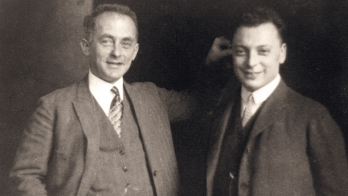by Howard Burton, Key Porter Books. Paperback ISBN 9781554701759, $24.95.

Science, usually an also-ran in the major funding stakes, is nevertheless occasionally surprised by generous benefactors. Just before the Wall Street crash in 1929, the Bloomberger family sold their department store to Macy’s of New York and altruistically invested the proceeds in what would become the Institute for Advanced Study (IAS), Princeton. This was not to be a university, and its research would not be dictated or contracted. With mathematical science high on its agenda, early members included Albert Einstein, John von Neumann and Kurt Gödel.
The IAS soon became a template for other research centres, both in the US and abroad. One of these was Israel’s Weizmann Institute, whose initial benefactors were the Sieff family, from another retailer, Britain’s Marks and Spencer. Another was India’s Tata Institute, supported by the mighty eponymous industrial combine. More recently came the foundation established by the Norwegian-American innovator Fred Kavli.
Another fresh venture is the Perimeter Institute (PI) for Theoretical Physics in Waterloo, Ontario, established in 1999 by Mike Lazaridis, co-founder of Research in Motion, the developers of the ubiquitous BlackBerry handsets. Lazaridis thrust an unsuspecting Howard Burton into the role of PI’s first executive director, with the job of getting the new institute up and running. This book is Burton’s memoirs of those heady days.
After labouring towards a PhD in theoretical physics, and with financial organizations snapping up numerate scientists, in 1999 Burton started looking for a job. The covering letter for his CV concluded with the line: “Please help save me from a lucrative career on Wall Street.” One CV went to Research in Motion. To Burton’s surprise a prompt and enthusiastic reply came from Lazaridis, who had an idea at the back of his mind and was looking for help to make it crystallize. Burton vividly conveys the difficulties of trying to sound enthusiastic in an interview for a job he didn’t even begin to understand.
Nevertheless, he was hired. To clarify his own ideas, he went far and wide to explore possibilities and seek out recruits. One early candidate was Roger Penrose at Oxford, whose foreword to the book is characteristically stimulating and enigmatic by turns. There is a hilarious anecdote about trying to make a telephone call from Penrose’s office. Another amusing episode comes when Burton goes to ask his former teacher at Guelph University to join the board of the new institute. On arrival, Burton is wrong-footed by being offered a postdoc position, which he immediately has to turn down and instead make his counter-offer to an even more surprised former teacher.
Soon, Burton was seeking other recruits and looking for suitable premises. With the first physicists in residence, attention turned towards establishing a working environment. Burton’s initial confusion was now inherited by scientists unused to Lazaridis’ work style. Burton’s chapter, “The trouble with physicists”, illustrates the culture shock when the brash commercial world meets the passive serenity of academia. Commendably, outreach was soon identified as a major objective at PI, with a successful series of public lectures and other events.
The book’s “crazy” subtitle and the offbeat cover illustration could be misleading: at first glance it is easy to assume that the book is eccentric. However, its informal style masks serious issues. PI aims to redress the balance in a world dominated – culturally, intellectually, technologically and economically – by scientific research, but which is nevertheless largely uncaring and unappreciative of the importance of science.
Because PI is an institute for theoretical physics, theorists especially will enjoy the book, and many well known figures flit across the pages. There is no official collective noun for theoretical physicists, but Burton’s acknowledgements include a list of about 200 of them, which surely qualifies for one (“galaxy”, “group”, “resonance”?).








